25 ways to build a comprehensive snippet

A snippet is a small piece of text that we see on the issue page along with a link to the site. Previously, the snippet contained only text, so all the 10 addresses that we saw on one page looked almost the same. The search engines were the first to think about how to solve this issue: show the user as much information as possible about the resource being sought, even in the issue, so that he would immediately go where he needs. For digital marketing, a snippet is an important tool in the struggle for user satisfaction. How to quickly build a high-quality and comprehensive snippet? Most recently, the digital agency PlayMedia published a detailed infographic of “10 ways to use extended snippets for Google,” which we recommend first. How to apply this knowledge in practice - read in our today's post.
')
Do I need to work with snippet now?
To begin with, let us turn to current trends, in order to decide how important it is to work with a snippet in general - is the game worth the candle? How relevant is the work with the snippet now and is it worth our time and effort, albeit small? Go to Google Trends and see the graph of the popularity of the query "snippet":
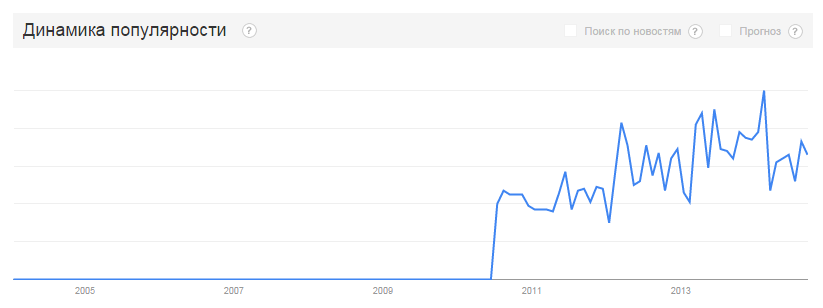
Source: http://www.google.com/trends/
Here we see that in Russia it is possible to trace the dynamics of growth, starting from 2010 to the present day. The next step is to try to estimate “approximately” how relevant this will be within the framework of search engine promotion and website promotion. To do this, let's turn our attention to the graph of the dynamics of the popularity of the request: “website promotion”. Comparison of the popularity of these requests will help us to follow the process of growing demand in the advanced management of the formation of snippets:
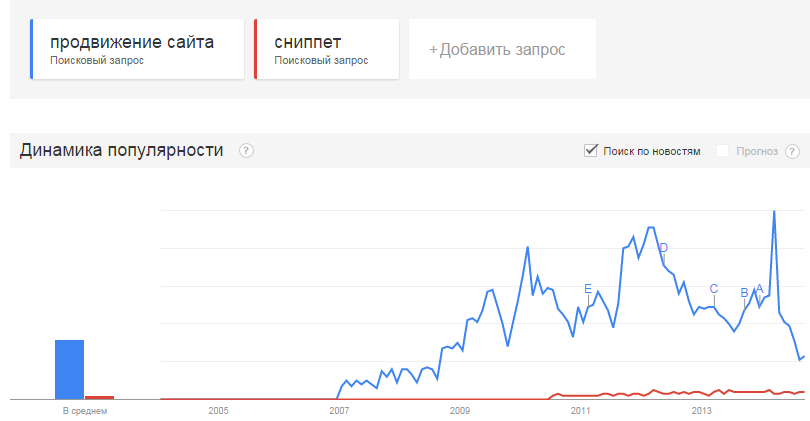
Source: http://www.google.com/trends/
Here you can see that with a certain increase in the popularity of the snippets theme, they have never been one of the primary trends in the issue of website promotion in search rankings. You can "play around" with the requests "traffic", "volume of external links", "positions" to see that the focus, of course, was on them.
Even taking into account the fact that there are large fluctuations in the popularity of the query “website promotion” and the formation of this chart clearly does not contain fluctuations in the popularity of the search engine itself, one thing is for sure - Since 2010 and up to now, the correct formation of a snippet is an integral part of promotion site!
What does this give us right now? Having made our snippet as user-friendly as possible, we can bring it to your website, even if we are not in the first place in the TOP, while other promotion specialists have not yet “reached out” to snippets.
HOW TO COMBINE A DRAWING SNIPPET?
Method 1: Affect the snippet header
For the title of the search result, the PM most often uses the title of the document itself (Title). If it is too long, the PM selects the fragment that best fits the given query.
Important: Write the Title using the keyword that is literally from the point of view of the Russian language its occurrence. Make the heading readable and add an impulse to the action. The user should be clear from the title that awaits him on the site.
Method 2: Affect the text of the snippet
Snippet text in Yandex
For the formation of the description of the page , Yandex selects all fragments of the text of the document with the words from the request. Each of these fragments is broken down into several parts — for example, with words from a query at the beginning, at the end, and in the middle. Then the program compares them all to each other and selects the best - and they fall into the snippet.
... if the word is contained in a long sentence, it is more likely that this is part of the story, and not a navigation link. This is a good snippet snippet ...
... and here is a fragment similar to the title of the text of the page, is unlikely to fall into the snippet - so as not to duplicate information ...
Source: https://company.yandex.ru/technologies
Snippet text in google
Google basically forms a snippet from the site description (Description meta tag). If the description for the page is not registered, or it contains irrelevant text, then the most relevant part of the page text is automatically displayed as a snippet.
Important: the description of the page for Google should be relevant. Although in this case, the PS can replace desc with what it deems necessary and show exactly this information in the snippet on a specific request.
Method 3: Use special characters
If you think about it, we don’t have too many options in order to stand out with a snippet, so as one of the extremes we will immediately consider this method and point out its possible "side effect". Special characters are easily added through a unique code of a coded text character.
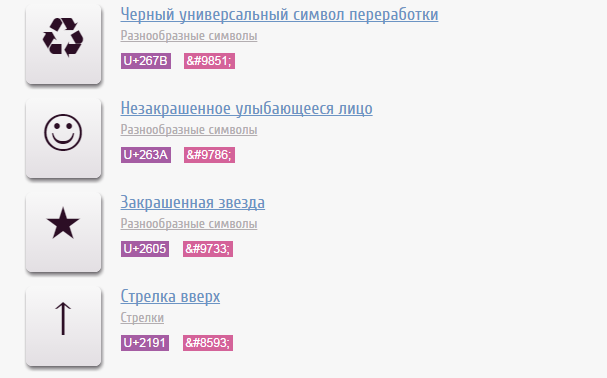
Complete Unicode character table: http://unicode-table.com/en/sets/sepecial-symbols/
It is possible to place special characters in the description and in the title and pages, but this should be done very carefully, observing moderation, otherwise it is easy to make such a snippet, which can be frankly scary to click:

Method 4: Use bread crumbs
Breadcrumbs is a website navigation element that represents the path through the site from its “root” to the current page where the user is located.
The name “Bread Crumbs” is an ironic reference to the German fairy tale “Hansel and Gretel”, in which the children, when they were brought into the forest a second time, could not find their way back, because this time instead of small pebbles they left bread crumbs behind them subsequently peeled forest birds.
All elements of bread crumbs, except the last, are usually internal hyperlinks.
Source: https://ru.wikipedia.org/wiki/
For Google, the most relevant way to form breadcrumbs is the use of micromarking (semantic micromarking) , Yandex also automatically creates breadcrumbs, mainly based on the hierarchy used by the site. An example of using microdata for the formation of the desired bread crumbs in the snippet:

Important: After creating bread crumbs or other micromarking, do not forget to check with the validator:
Google: http://www.google.com/webmasters/tools/richsnippets
Yandex: http://webmaster.yandex.ru/microtest.xml
Method 5: Draw a good favicon
Favicon is a small icon that is placed next to the search results, it is also placed in the site tab. Raise your eyes up in the browser and look at the Habr tab: do you see the favicon H? (your answers in the comments). The same favicon you see in search results with search results leading to Habr.
Favicon is the main visible element, invariably reflected on all snippets and on all ranked queries. If the favicon is made bright and attractive, then it is likely that with the permanent appearance of your icon in front of your eyes, the next time the user will choose your own among other sites.
Important: favicon.ico must be on the site always!
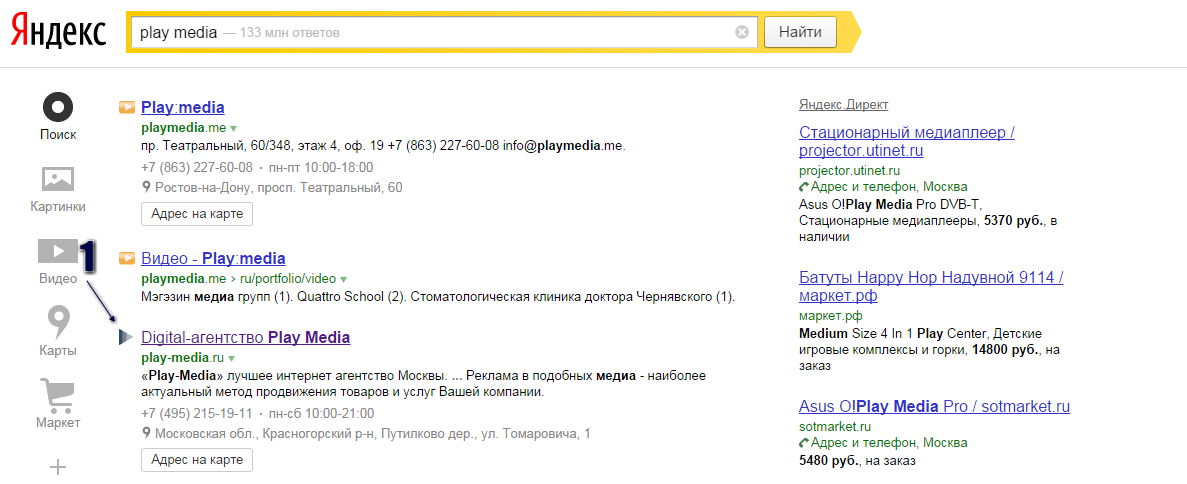
Method 6: Specify the date of publication
The date of publication is shown in cases where it matters to the user. For example, if we are talking about a snippet blog.
Important: If there is a news feed or a message feed on the site, then you need to configure the formation of the URL so that it clearly contains a date ( / yyyy / mm / dd / or / yyyy-mm-dd / )
Method 7: Edit Quick Links
Quick links are links to popular sections of the site that can be displayed in a snippet.
Editing quick links in the Yandex snippet is possible from the site management office on Yandex.Webmaster.
Google, in turn, has a process similar to Yandex for the automated addition of links, but unlike Yandex, it does not give direct access to editing quick links, and can also lower the URL rating of an inappropriate link.
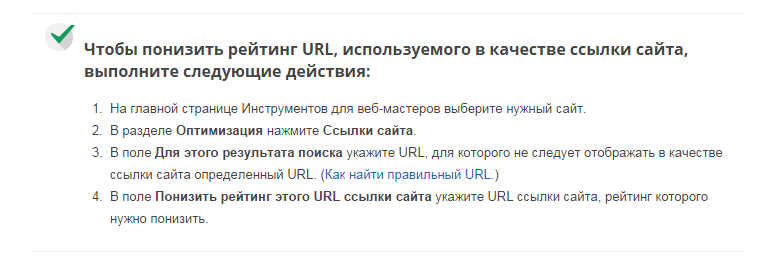
Source: https://support.google.com
If the PS is fairly loyal to the site, the site has good behavioral and citation levels, then you can see the picture when Google adds its own unique descriptions to the main quick links:

Source: https://google.com
In this case, the height of such a snippet is three times the standard snippet, which makes it much more noticeable and clickable.
Method 8 (more irrelevant): Add social networking icons
Although at the moment the integration of snippet with social networks is not relevant, we present the details of this “ancient” method in case the search engines return this opportunity.
Icons of social networks in Yandex
Improved snippet display due to the presence of company social networking icons was available some time ago. Adding icons was edited in the card I. Organization of the site, in the tab “Links to social networks”. At the moment, there is no exact information about the functional life of the output of social networks in the Yandex snippet. The fact is that he was and there is a high probability of his return, as the tab “Links to pages in social networks” still exists and there is no announcement of the closure of such a possibility of informing the audience.
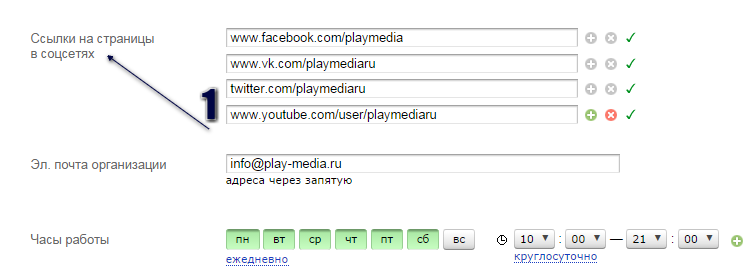
Source: http://sprav.yandex.ru/
Icons of social networks in Google
After the launch of the social network Google+, for some time the snippet had a +1 icon for recommending a page to friends and the recommendations of friends on Google+ were displayed. Now the presence of this button on the site is more likely to be behavioral, rather than snippet. However, the button is in any case recommend you add. Make it easy: / p>

Source: https://developers.google.com (here is a complete description of this process)
Method 9: Enable Twitter and hashtags
Actual information from Twitter is updated almost in real time. This fact makes it possible to isolate this social network into a separate “constantly re-indexed” group of sites, in which news publications are mainly located.
Important: we get the possibility of fast indexing, by publishing a link to the page of interest to us in Twitter.com.
If we want to change the header or description of the snippet as quickly as possible, after the correction of these parameters on the site, it is best to inform the audience of your Twitter account about the event with a link to the page being ranked between two popular tags such as: #megaindex or # dentistry

Source: https://twitter.com/megaindex
Method 10: Add to Yandex. Reference
Yandex.Spravochnik allows you to add the address and data about the organization, which can also be ultimately reflected in the snippet. Currently it is possible for the following organizations:
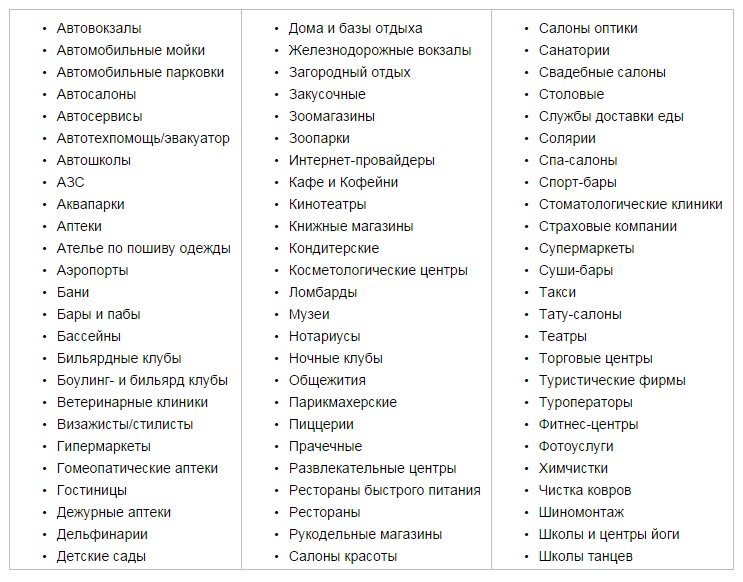
Source: http://help.yandex.ru
For each type of organization, their own parameters are selected, the most interesting to users. For example, a snippet of the company's official site might look like this:

Source: http://help.yandex.ru
All data about organizations is collected and edited in the Yandex service. Organizations are displayed not only in snippets, but also in other Yandex services. Sign up For some specific topics there is the possibility of displaying the Sign up button directly to the snippet.

Source: http://help.yandex.ru
Also, this button is available on Yandex.Map, but only for some clinics or beauty salons.

Source: http://maps.yandex.ru
The record is available to organizations that have entered into a cooperation agreement with Yandex partners:
For restaurants, cafes and other establishments
ZON , GetTable , LeClick , Reserve Online , Gourmet , Restoran.ru , Tomesto , Menu.ru , Restaurant Rating
For clinics
InfoDoctor , DocDoc.Ru , Timetovisit , Online Clinics , YClients , GBooking , Timeliner , LookMedBook , Doctu.ru , GidPoZubam , Medihost
For beauty salons
SON , YClients , GBooking , Timeline , Royal Beauty , Carendar
For hotels
booking , island , hrs , oktogo , vashotel
For booking directly on the hotel website
wubook travelline
Method 11: Add to Yandex.Market
How can the store improve its snippets and attract visitors interested in buying to its site? The first is to simply upload your products to Yandex.Market , and then information about products will be automatically “translated” and searched. The second (if participation in the Market is not interesting for a store for some reason) - download information about products via Yandex.Webmaster - this is completely free.

You can participate in the snippet improvement program if:
- Your website is an online store, an offline store representative office, a company providing services, or a website aggregating offers from other companies.
- Your website is hosted on an English domain.
- The site contains a catalog of products / services and for each product / service there is a separate page on your site.
- The site is available contact and legal information about your company.
- Goods in your store can be purchased by an individual at retail.
- You have read and agree to the requirements and conditions listed in the Terms of Cooperation .
To find out how to connect to the Snippet Improvement Program, go to the Connecting Store section.
Source: http://help.yandex.ru
Method 12: Use Yandex. Services
To participate in the Yandex.Services affiliate program, you must provide information about, for example, which deposits and loans the bank considers necessary to place on the service. Send data on deposits and credits to Yandex by creating an XML feed in a special format and posting it on your website, specifying the path to the file in the Yandex.Webmaster form of service provided for this purpose .
An agreement on information cooperation is concluded with all partners.
Method 13: Share recipes correctly
For culinary recipe pages, a snippet containing structured information can be generated that helps the user to quickly understand the characteristics of your recipe and select the desired link among multiple identical headers.

Source: http://yandex.ru
To generate such a snippet, you will need to organize the transfer of data about your recipes to Yandex by creating an XML feed in a special format , place it on the website and specify the path to the file in the Yandex.Webmaster form of service provided for this .
To form a snippet with photoreceptors, it is necessary to place at least three illustrations + it is desirable to add semantic micromarking in hRecipe or Schema.org format to the HTML code of pages containing recipes.
Method 14: Join the Yandex.Dictionaries Affiliate Program
In order to fully take advantage of the capabilities of the Yandex.Dictionaries service, first of all, it is necessary to study the requirements for partner sites by Yandex.
Sites containing a significant amount of vocabulary and reference content materials (hereinafter: “articles,” the totality of articles is referred to as “vocabulary”) are invited to the affiliate program. The site as a whole, dictionaries, separate articles from them and pages of the site on which articles are posted must meet the requirements described below:
- The site should not contain content for adults, as well as information of an illegal nature, including materials that promote incitement of ethnic hatred or incite to violence.
- The site, the main purpose of which is the promotion of goods and services, can participate in an affiliate program for the decision of the moderator.
- If there are other materials on the site, along with the dictionary, the section with articles should be structurally and visually separated from other parts of the site.
- The tic of the site should be more than 100. Sites with a lower tIc can participate in the program by the decision of the moderator.
- The site should not upload viruses and other malicious programs to users' computers.
Source: http://help.yandex.ru
In the search results for pages with dictionary entries, a special snippet will be formed, which can also be enhanced by semantic micromarking.

Source: http://help.yandex.ru
Method 15: Use the special markup for the abstract
For pages with a description of your abstract, a special snippet may be displayed. This snippet includes those attributes of the essay that are important to the user when deciding on the download: category, type of work (abstract, coursework, diploma, report), date of addition, number of downloads, abstract or table of contents.

Source: http://yandex.ru
For which sites and pages is it possible to create a special snippet?
- The site should be abstract. An abstract is considered to be a resource that provides students of various educational institutions with the opportunity to independently publish written work performed as part of the curriculum, as well as allowing users to download or view these works free of charge.
- Special snippets are formed for pages that are abstract cards: information on only one abstract should be placed on the page, and this information should be the main content of the page. The abstract card may contain the actual text or the beginning of the abstract text, or it may not.
Source: http://help.yandex.ru
Method 16: Properly Place Jobs
Participation in the affiliate program of Yandex.Work allows you to significantly increase the attendance of recruiting sites and partially expand the target audience.
If you are the owner or administrator of such a site, first of all you need to study the requirements for a potential participant of the program by Yandex.
To check the quality for participation in the Yandex.Work service, a resource is accepted, the export file of which:
- does not contain errors XML, XSD-validation;
- contains at least 70 valid vacancies (not copies, with telephone numbers);
- with a share of valid ads - at least 50%;
- with fresh vacancies posted in the last 5 days.
A complete list of requirements can be found at the link to the source.
Source: http://help.yandex.ru
Method 17: Snippet and reviews
At the moment for Yandex special snippets are generated only for reviews about cars.
There are several ways to include ratings in reviews for Google. Often, it is only necessary to indicate next to the reviews / * Rating: 4.5 * / and this will be enough to post the assessment in the reviews.
Regardless of the method of calculation you choose, it is possible to transmit this information using markup using microdata, microformats or RDFa (or Resource Description Framework in Attributes).
RDFa is a content markup method for describing a specific data type, such as a restaurant review, event, person, or product data. These data types are called entities or elements. Each entity has a number of properties. For example, the entity “person” includes such properties as name, address, position, place of work, and email address.
Source: http://support.google.com
Google also strongly advises not to add evaluation instructions as a separate hidden unit, since hidden content will not be shown.
Method 18: Yandex. Snippet
Each announcement by a participant in the Yandex.Management program is displayed as a snippet with basic information about the offer, though basically this snippet can be seen on the search pages in Yandex.Real Estate and only rarely in the main issue in case of a high level of relevance of the request.

Source: http://help.yandex.ru
With all the information about the requirements for partners and sites associated with the Yandex.Real estate program, you can find here.
Method 19: Auto-Ads and Snippets
Participation in the Yandex.Avto affiliate program allows site owners with private and commercial advertisements on automotive topics to increase traffic to their resources and expand their audience. Participation in the program is voluntary and free of charge ...
Source: http://help.yandex.ru
The main bonus for the participants of this program is the ranking itself of the announcements on the Yandex.Auto service and the possibility of getting your proposal in the block integrated above the search results, which is placed only on the pages of relevant automotive topics.

Source: http://yandex.ru
Method 20: Video and Snippets
For video content owners, Yandex offers indexing capabilities for videos that are publicly available on the Internet.
After Yandex has indexed your videos, they will be available for search on the Yandex.Video service, the screensaver picture, headings, text description and other service information will be placed on the search results pages, as well as previewing the videos.
Learn more about how to transfer data about Yandex videos here .
An extended video snippet looks like this:

Source: http://yandex.ru
Google supports schema.org markup and moreover, it even advises all its users to use micro-markup.
In order for Google to index your video, you need to use the type schema.org/VideoObject.
Next, make sure that you do not need JavaScript or Flash to access the video and markup.
In order for Google to find and index your video, you need to add markup directly to the html page on which your video is located.
Method 21: Original texts and snippets
If you publish on your website texts that have not previously been published on the Internet, and are reprinted by other Internet resources, warn Yandex about the imminent release of the text. We will know that the original text first appeared on your website, and we will try to use it in setting up search algorithms.
You can download the text through the form in Yandex.Webmaster. It is necessary to download only original texts that have not yet been published on the Internet. The recommended minimum volume is 500 characters, the maximum is 32,000 characters. You can publish the text on the site immediately after the application is accepted.
Source: http://help.yandex.ru
Method 22: Micromarking
Basically, most of the options for extending the snippet in Google occur automatically. To be able to manage or somehow influence the process of creating snippets of web pages of your site, you need to use microdata, i.e. additional properties written in the code specifically for the search robot.
Why do we need micromarking

Source: http://help.yandex.ru
As it gradually becomes clear, at the moment, micromarking is a key universal option for expanding snippets.
Compare the marked up and not marked up snippets from J. Help
The site does not use semantic markup:

The site uses semantic markup:

Source: http://help.yandex.ru
Let's go through the main options, the ability to use which we have at the moment:
Method 23: Events and Snippets
Many users search the web for information about events every day, with extended descriptions to help them find your events even faster. In order for the extended descriptions to be correctly displayed in the search results in the HTML code of the page you need to add a micromarking.
One of the main dictionaries that perfectly recognizes Google and Yandex is schema.org.

Source: http://google.com The
extended event snippet contains additional information fields with quick links to go: date, name and location .
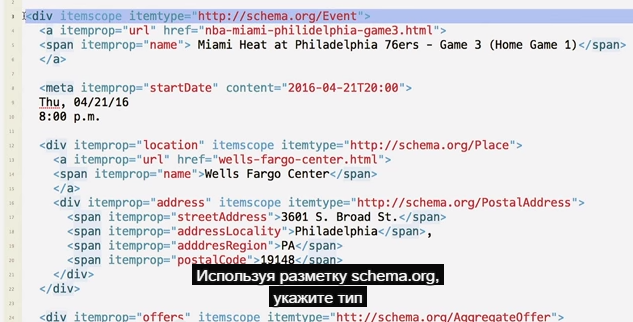
Method 24: Add your organization to Google Maps
Google has the ability to automatically identify your organization and add it to your cards. With the help of microdata, you can help the robot determine your Organization.
Each organization may have a number of different properties, such as name, address, URL, and phone number. You can mark these properties using microdata , microformats or RDFa . Google recognizes the following organization properties inherited from the hCard microformat. The same property name can be used for microdata, microformats, and RDFa. If the names of microdata properties / RDFa and microformats are different, the name of the microformats property is enclosed in brackets. Properties in bold are required.
Source: http://support.google.com
Method 25: Islands
Islands is a new platform from Yandex, which allows to improve the presentation of sites in search results. Islands do not replace the description of the site, and are their addition. They may include both a text block and add. information from the site, and integrated elements.
On the one hand, everything is very good, an opportunity has appeared from a search page to increase CRT by means of creating excellent and advanced “Islands”.
On the other hand, the Islands are an experimental technology and are fully available only in the Beta version of the search - beta.yandex.ru .
Better to see once. An example of a snippet extended by the Island:
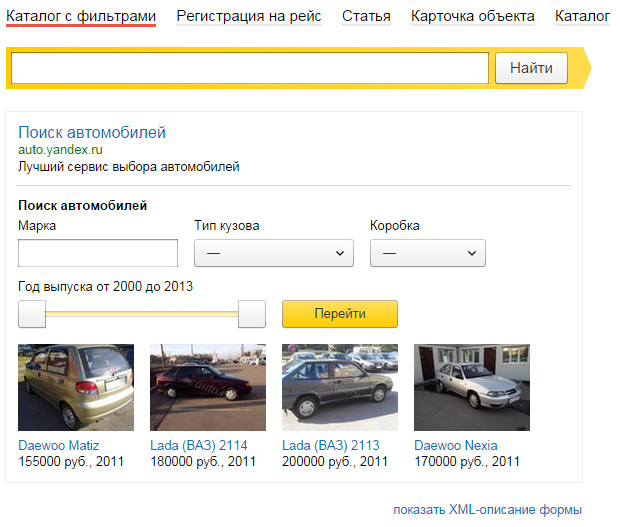
Source: http://islands.yandex.ru
In this example, it is clearly noticeable how from the usual “Description” the snippet turned into a real calculator with a transition to the website for working out the functionality.
Given that the reputation of Yandex is obviously higher than yours, such a calculator can become a real gold mine + those who will actively use the islands will obviously increase behavioral factors, which is currently one of the main ranking criteria.
True, there are downsides:
- The volume of round-the-clock traffic on beta.yandex.ru is much lower than the volumes mastered by its elder brother;
- There is no exact information about the full launch of the project;
- The presence of islands on the direct does not affect the ranking of the site;
Yandex about the “Islands”:
The concept of the “Islands” could not be translated into the framework of the old design. The usual list of links is not able to accommodate the diverse content that sites can offer. Therefore, Yandex search will have a new design. When developing it, we were guided by two basic principles - “interface relevance” and “important things are immediately visible.” Source: http://blog.yandex.ru
In conclusion about islands:
“Islands” do not change ranking algorithms, therefore launching a new platform should not will affect the position of sites. The best places, as before, will occupy the most useful answers to users.
Source: http://blog.yandex.ru
There is a high probability that if you suddenly launch islands.yandex.ru is successful, it will in any case affect the ranking, ranging from the influence of behavioral when choosing a site on the user’s search pages, unless Yandex decides to take into account the activity from the “Islands”, as with the direct, ending with the appearance of yet another unexamined, unique tool marketing.
Conclusion
In conclusion, I must say that before working on snippets, it is necessary to consider the procedure for working and the following aspects related to this topic:
- To begin to check the availability and adequacy of all materials on the site (this is a priority task)
- Check for a beautiful favicon
- Consider the use of special characters in the title (there may be only one and not on all pages, for example, if your logo is star, then the special symbol “Filled star” may suit you, and your visitors will begin to search for your special character)
- The next step is to learn the schema.org library.
- Next, we apply the obtained knowledge about the micromarking to form the correct bread crumbs in the snippet.
- After creating bread crumbs or other micromarking, do not forget to check with the validator:
Google: www.google.com/webmasters/tools/richsnippets
Yandex: webmaster.yandex.ru/microtest.xml
- Register your site with Yandex and Google Webmasters and customize Quick Links
- Be sure to register on “Cards” and “Organizations”
- Post Jur. information about your organization on the page “Contacts”
- After that, be sure to pay attention to the list of options for expanding the snippet.
Additional materials:
Additional information on snippets can be found in this infographic from Play Media and also in these materials:

Source: https://habr.com/ru/post/241618/
All Articles